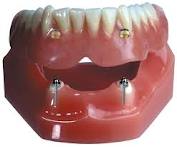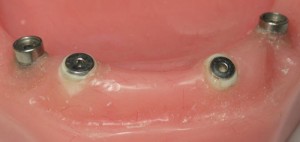Introduction
An overdenture is a partial or complete denture that are supported by one or more remaining natural teeth or implants; these supporting teeth or implants are called “abutmentsâ€. The overdenture may be attached to the abutments by 2 means: mechanical (ball and bar attachments) and magnetic attachment. Overdentures with magnetic attachments are called “Magnetic dentures“. Magnets have become very popular as retainers since the 1950’s. According to The Times, in 1957, a Cornell University Medical College professor developed a denture that was held in place by embedding powerful magnets in the patients jaw bone. The magnets were made from aluminum–nickle–cobalt (AlNiCo) alloys. However, this means of achieving retention had limited success, as they were associated with a few problems:
Problems with the early magnetic dentures
- Significantly lower retentive forces than those offered by bar or ball attachments.
- AlNiCo alloys corrode rapidly in saliva.
- They are subject to wear and demagnetization.
Recent Developments
Newer magnetic systems were made from alloys of the rare earth elements samarium (SmCo) and neodymium (NdFeB). This system is stronger and has a more stable magnetic force than before, because they have high magnetization and high resistance to demagnetization.
In addition, a new generation of laser-welded containers (welded with stainless steel containing nickel) has improved protection from salivary corrosion. According to the manufacturer (MAGFIT, Aichi Steel Corporation), fewer than 1 in 10 capsules associated with overdentures on natural teeth separated from the denture base during an 8-year clinical trial. In addition, none experienced loss of magnetic attraction. The manufacturer also reported that a veneer of ceramic titanium nitride was applied to the container to resist abrasion and reduce the patient’s exposure to nickel. Nonetheless, until there is stronger evidence to support these claims, it would be prudent to avoid this magnetic system for patients with an allergy to nickel.
Â
Advantages of magnetic over mechanical attachments
- It is easier to insert or remove the denture, as there is no specific path of insertion. This is particularly a bonus for patients with limited dexterity, such as the elderly.
- In mechanical attachments through the use of bar or ball attachments, it is essential that the abutments are parallel to each other, so that chewing forces are transferred along the long axis of the abutment, and not laterally. If an implant is to be used as an abutment, it has to be parallel to the other remaining teeth and to each other. However, no abutment parallelism is required in magnetic dentures, as retention is achieved through magnetic attraction.
- Soft tissue undercuts may be engaged
- There is a reduced lateral force on the abutments with magnetic dentures. Lateral forces can badly influence the supporting teeth or implants.
- No wear, no servicing require
- Magnetic attachments used to retain dentures are typically shorter than mechanical attachments. This is an advantage for patients with decreased interocclusal space (the vertical distance between upper and lower jaw).
- The lifespan of a magnetic force is infinite, which means that the retentive force of a magnetic unit lasts longerthan that of mechanical attachments.
Disadvantages of magnetic dentures
- Magnets may cause distortion during magnetic resonance imaging (MRI) of the head and neck. Thus the patients should have their dentures with magnets removed and have the magnetic components (the “keepersâ€) unscrewed from the implants before an MRI is done on the head and neck. As with most metallic dental materials, there is minimal risk of patient injury through displacement of the keeper component during MRI, provided the keepers are properly attached within the mouth.
- The long-term protection from salivary corrosion within the protective capsules is still uncertain.
- Although it is reported that both mechanical and magnetic attachments do not cause harm to the underlying supporting tissues (gums and bone), there have been reports of more plaque collecting around magnetic attachments than around mechanical attachments, for reasons unknown. Assad and colleagues suggested that magnets attract microbial plaque, but it has also been suggested that because of its emergence profile, the magnetic keeper may trap plaque around the implant where it emerges from the mucosa or that denture-wearers who were dissatisfied with the retention of their dentures were not motivated to keep them clean.
Patient Satisfaction
According to the Journal of the Canada Dental Association (JDCA) dated 16th September 2010, in a 10-year randomized clinical trial, there was no difference in general satisfaction with a magnetic attachment system for retaining lower complete dentures and 2 types of mechanical attachments (ball or bar systems), although the dentures retained by magnets were subjectively less stable and less comfortable than dentures retained by mechanical attachments.


